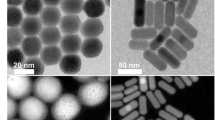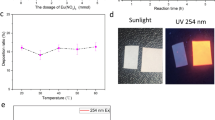Abstract
Fluorescent patterning has attracted a great deal of attention owing to its potential applications in different areas in particular anti-counterfeiting technology. Fluorescent carbon dots (CDs) as a type of fluorescent dyes can be used in invisible patterning due to their remarkable optical properties. This study attempts to introduce green fluorescent CDs as a promising factor in textile coding. Accordingly, a new green source opted to prepare CDs using the hydrothermal approach. Moreover, toxicity assays were performed to prove the safety of these carbon-based nanoparticles for humanity. They were also conjugated with cotton fiber successfully. Therefore, these green prepared CDs are promising for security labeling in the textile industry.





Similar content being viewed by others
References
Jiang K, Wang Y, Cai C, Lin H. Conversion of carbon dots from fluorescence to ultralong room-temperature phosphorescence by heating for security applications. Adv Mater. 2018;30(26):1800783.
Andres J, Hersch RD, Moser JE, Chauvin AS. A new anti-counterfeiting feature relying on invisible luminescent full color images printed with lanthanide-based inks. Adv Funct Mater. 2014;24(32):5029–36.
Yoon B, Lee J, Park IS, Jeon S, Lee J, Kim J-M. Recent functional material based approaches to prevent and detect counterfeiting. J Mater Chem C Mater. 2013;1(13):2388–403.
Roberts CM. Radio frequency identification (RFID). Comput Secur. 2006;25(1):18–26.
Huang S, Wu JK. Optical watermarking for printed document authentication. IEEE Trans Inform Forensic Secur. 2007;2(2):164–73.
Han S, Bae HJ, Kim J, Shin S, Choi SE, Lee SH, et al. Lithographically encoded polymer microtaggant using high-capacity and error-correctable QR code for anti-counterfeiting of drugs. Adv Mater. 2012;24(44):5924–9.
Niu N, Yang P, He F, Zhang X, Gai S, Li C, et al. Tunable multicolor and bright white emission of one-dimensional NaLuF 4: Yb 3+, Ln 3+(Ln = Er, Tm, Ho, Er/Tm, Tm/Ho) microstructures. J Mater Chem. 2012;22(21):10889–99.
Chang K, Liu Z, Chen H, Sheng L, Zhang SXA, Chiu DT, et al. Conjugated polymer dots for ultra-stable full-color fluorescence patterning. Small. 2014;10(21):4270–5.
Wei S-C, Lin Y-W, Chang H-T. Carbon dots as artificial peroxidases for analytical applications. J Anal Test. 2019;3:191–205.
Geng F, Zhao L, Kang Y, Guo L-H. Unprecedented two-step chemiluminescence of polyamine-functionalized carbon nanodots induced by fenton-like system. J Anal Test. 2017;1(4):315–21.
Li X, Shi L, Li L, Dong C, Li C-Z, Shuang S. Recent advances in carbon nanodots: properties and applications in cancer diagnosis and treatment. J Anal Test. 2019;3(1):37–49.
Puvvada N, Kumar BP, Konar S, Kalita H, Mandal M, Pathak A. Synthesis of biocompatible multicolor luminescent carbon dots for bioimaging applications. Sci Technol Adv Mater. 2012;13(4):045008.
Prabhakar N, Näreoja T, von Haartman E, Karaman DŞ, Burikov SA, Dolenko TA, et al. Functionalization of graphene oxide nanostructures improves photoluminescence and facilitates their use as optical probes in preclinical imaging. Nanoscale. 2015;7(23):10410–20.
Cao L, Sahu S, Anilkumar P, Bunker CE, Xu J, Fernando KS, et al. Carbon nanoparticles as visible-light photocatalysts for efficient CO2 conversion and beyond. J Am Chem Soc. 2011;133(13):4754–7.
Zhao HX, Liu LQ, De Liu Z, Wang Y, Zhao XJ, Huang CZ. Highly selective detection of phosphate in very complicated matrixes with an off–on fluorescent probe of europium-adjusted carbon dots. Chem Commun. 2011;47(9):2604–6.
Zhu S, Meng Q, Wang L, Zhang J, Song Y, Jin H, et al. Highly photoluminescent carbon dots for multicolor patterning, sensors, and bioimaging. Angew Chem Int Ed. 2013;52(14):3953–7.
Qu S, Wang X, Lu Q, Liu X, Wang L. A biocompatible fluorescent ink based on water-soluble luminescent carbon nanodots. Angew Chem Int Ed. 2012;51(49):12215–8.
Li H, Kang Z, Liu Y, Lee S-T. Carbon nanodots: synthesis, properties and applications. J Mater Chem. 2012;22(46):24230–53.
Fatahi Z, Esfandiari N, Ehtesabi H, Bagheri Z, Tavana H, Ranjbar Z, et al. Physicochemical and cytotoxicity analysis of green synthesis carbon dots for cell imaging. EXCLI J. 2019;18:454–66.
Ashrafi Tafreshi F, Fatahi Z, Ghasemi SF, Taherian A, Esfandiari N. Ultrasensitive fluorescent detection of pesticides in real sample by using green carbon dots. PLoS ONE. 2020;15(3):e0230646.
Mao X-J, Zheng H-Z, Long Y-J, Du J, Hao J-Y, Wang L-L, et al. Study on the fluorescence characteristics of carbon dots. Spectrochim Acta A Mol Biomol Spectrosc. 2010;75(2):553–7.
Hu S, Wei Z, Chang Q, Trinchi A, Yang J. A facile and green method towards coal-based fluorescent carbon dots with photocatalytic activity. Appl Surf Sci. 2016;378:402–7.
Sharma V, Tiwari P, Mobin SM. Sustainable carbon-dots: recent advances in green carbon dots for sensing and bioimaging. J Mater Chem B. 2017;5(45):8904–24.
Hu S-L, Niu K-Y, Sun J, Yang J, Zhao N-Q, Du X-W. One-step synthesis of fluorescent carbon nanoparticles by laser irradiation. J Mater Chem. 2009;19(4):484–8.
Ding H, Yu S-B, Wei J-S, Xiong H-M. Full-color light-emitting carbon dots with a surface-state-controlled luminescence mechanism. ACS Nano. 2016;10(1):484–91.
Minh TuN, Thanh L, Une A, Ukeda H, Sawamura M. Volatile constituents of Vietnamese pummelo, orange, tangerine and lime peel oils. Flavour Fragr J. 2002;17(3):169–74.
Dubey P, Tripathi KM, Sonkar SK. Gram scale synthesis of green fluorescent water-soluble onion-like carbon nanoparticles from camphor and polystyrene foam. RSC Adv. 2014;4(12):5838–44.
Ding H, Wei J-S, Xiong H-M. Nitrogen and sulfur co-doped carbon dots with strong blue luminescence. Nanoscale. 2014;6(22):13817–23.
Sharma A, Gadly T, Gupta A, Ballal A, Ghosh SK, Kumbhakar M. Origin of excitation dependent fluorescence in carbon nanodots. J Phys Chem Lett. 2016;7(18):3695–702.
Ding H, Ji Y, Wei J-S, Gao Q-Y, Zhou Z-Y, Xiong H-M. Facile synthesis of red-emitting carbon dots from pulp-free lemon juice for bioimaging. J Mater Chem B. 2017;5(26):5272–7.
Pan D, Zhang J, Li Z, Wu M. Hydrothermal route for cutting graphene sheets into blue-luminescent graphene quantum dots. Adv Mater. 2010;22(6):734–8.
Wei L, Ma Y, Shi X, Wang Y, Su X, Yu C, et al. Living cell intracellular temperature imaging with biocompatible dye-conjugated carbon dots. J Mater Chem B. 2017;5(18):3383–90.
Mehta VN, Chettiar SS, Bhamore JR, Kailasa SK, Patel RM. Green synthetic approach for synthesis of fluorescent carbon dots for lisinopril drug delivery system and their confirmations in the cells. J Fluoresc. 2017;27(1):111–24.
Bandi R, Dadigala R, Gangapuram BR, Guttena V. Green synthesis of highly fluorescent nitrogen–doped carbon dots from Lantana camara berries for effective detection of lead (II) and bioimaging. J Photochem Photobiol B: Biol. 2018;178:330–8.
Zhang J, Shen W, Pan D, Zhang Z, Fang Y, Wu M. Controlled synthesis of green and blue luminescent carbon nanoparticles with high yields by the carbonization of sucrose. New J Chem. 2010;34(4):591–3.
Chandra S, Pathan SH, Mitra S, Modha BH, Goswami A, Pramanik P. Tuning of photoluminescence on different surface functionalized carbon quantum dots. RSC Adv. 2012;2(9):3602–6.
Sahu S, Behera B, Maiti TK, Mohapatra S. Simple one-step synthesis of highly luminescent carbon dots from orange juice: application as excellent bio-imaging agents. Chem Commun. 2012;48(70):8835–7.
Gao Z, Wang L, Su R, Huang R, Qi W, He Z. A carbon dot-based “off–on” fluorescent probe for highly selective and sensitive detection of phytic acid. Biosens Bioelectron. 2015;70:232–8.
Esfandiari N, Bagheri Z, Ehtesabi H, Fatahi Z, Tavana H, Latifi H. Effect of carbonization degree of carbon dots on cytotoxicity and photo-induced toxicity to cells. Heliyon. 2019;5(12):e02940.
Xu Q, Kuang T, Liu Y, Cai L, Peng X, Sreeprasad TS, et al. Heteroatom-doped carbon dots: synthesis, characterization, properties, photoluminescence mechanism and biological applications. J Mater Chem B. 2016;4(45):7204–19.
Laptinskiy KA, Burikov SA, Patsaeva SV, Vlasov II, Shenderova OA, Dolenko TA. Absolute luminescence quantum yield for nanosized carbon particles in water as a function of excitation wavelength. Spectrochim Acta A Mol Biomol Spectrosc. 2020;229:117879.
Li Z, Zhang Y, Niu Q, Mou M, Wu Y, Liu X, et al. A fluorescence probe based on the nitrogen-doped carbon dots prepared from orange juice for detecting Hg2+ in water. J Lumin. 2017;187:274–80.
Alam A-M, Park B-Y, Ghouri ZK, Park M, Kim H-Y. Synthesis of carbon quantum dots from cabbage with down-and up-conversion photoluminescence properties: excellent imaging agent for biomedical applications. Green Chem. 2015;17(7):3791–7.
Esfandiari N. Targeting breast cancer with bio-inspired virus nanoparticles. ABC. 2018;5(2):90–5.
Nurunnabi M, Khatun Z, Huh KM, Park SY, Lee DY, Cho KJ, et al. In vivo biodistribution and toxicology of carboxylated graphene quantum dots. ACS Nano. 2013;7(8):6858–67.
Chong Y, Ma Y, Shen H, Tu X, Zhou X, Xu J, et al. The in vitro and in vivo toxicity of graphene quantum dots. Biomaterials. 2014;35(19):5041–8.
Sachdev A, Gopinath P. Green synthesis of multifunctional carbon dots from coriander leaves and their potential application as antioxidants, sensors and bioimaging agents. Analyst. 2015;140(12):4260–9.
Feng T, Zeng Q, Lu S, Yan X, Liu J, Tao S, et al. Color-tunable carbon dots possessing solid-state emission for full-color light-emitting diodes applications. ACS Photonics. 2018;5(2):502–10.
Acknowledgements
Special thanks go to Professor Vlasov Igor for supporting us with helpful comments that greatly improved the manuscript.
Author information
Authors and Affiliations
Corresponding author
Ethics declarations
Conflict of interest
The authors declare no conflicts of interests.
About this article
Cite this article
Fatahi, Z., Esfandiari, N. & Ranjbar, Z. A New Anti-counterfeiting Feature Relying on Invisible Non-toxic Fluorescent Carbon Dots. J. Anal. Test. 4, 307–315 (2020). https://doi.org/10.1007/s41664-020-00149-6
Received:
Accepted:
Published:
Issue Date:
DOI: https://doi.org/10.1007/s41664-020-00149-6




